Nursing Assignment: Applying Clinical Reasoning to Patient Care
VerifiedAdded on 2021/04/21
|10
|2680
|123
Essay
AI Summary
This nursing assignment utilizes the clinical reasoning cycle to analyze the case of Peter Mitchell, a 52-year-old patient with morbid obesity and type 2 diabetes. The essay meticulously applies the eight steps of the clinical reasoning cycle to assess the patient's condition, including his history of hypertension, sleep apnea, and smoking habits. Through this process, the assignment identifies two primary care priorities: managing obesity and controlling poorly managed diabetes. The essay provides a detailed rationale for these priorities, emphasizing the need for lifestyle interventions, including dietary changes, increased physical activity, and smoking cessation therapy. Furthermore, the assignment outlines specific nursing interventions, such as medication management and patient education, to achieve the set goals. The effectiveness of these interventions is evaluated by assessing vital signs and patient compliance, which informs continuous professional development and improved patient care strategies.
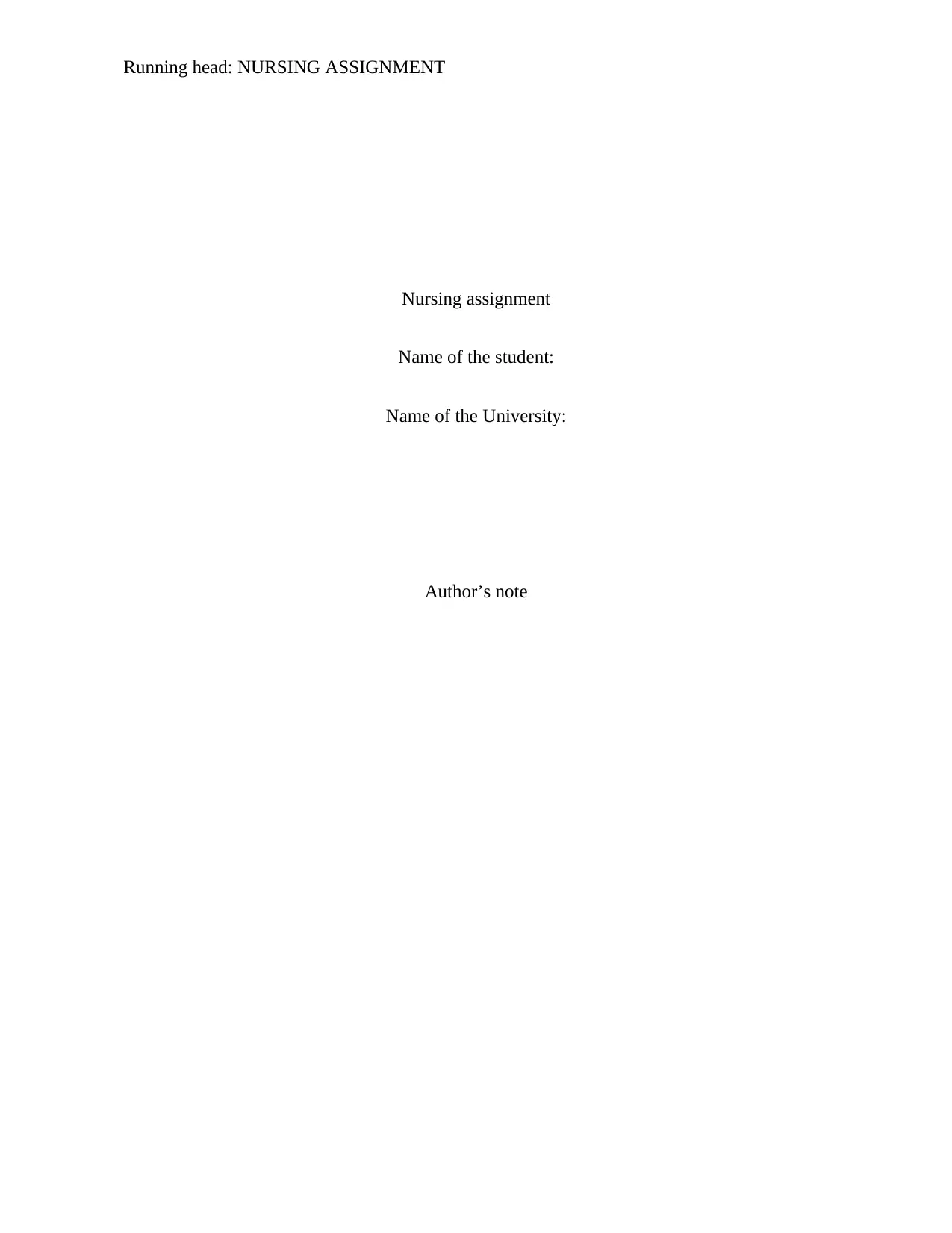
Running head: NURSING ASSIGNMENT
Nursing assignment
Name of the student:
Name of the University:
Author’s note
Nursing assignment
Name of the student:
Name of the University:
Author’s note
Paraphrase This Document
Need a fresh take? Get an instant paraphrase of this document with our AI Paraphraser
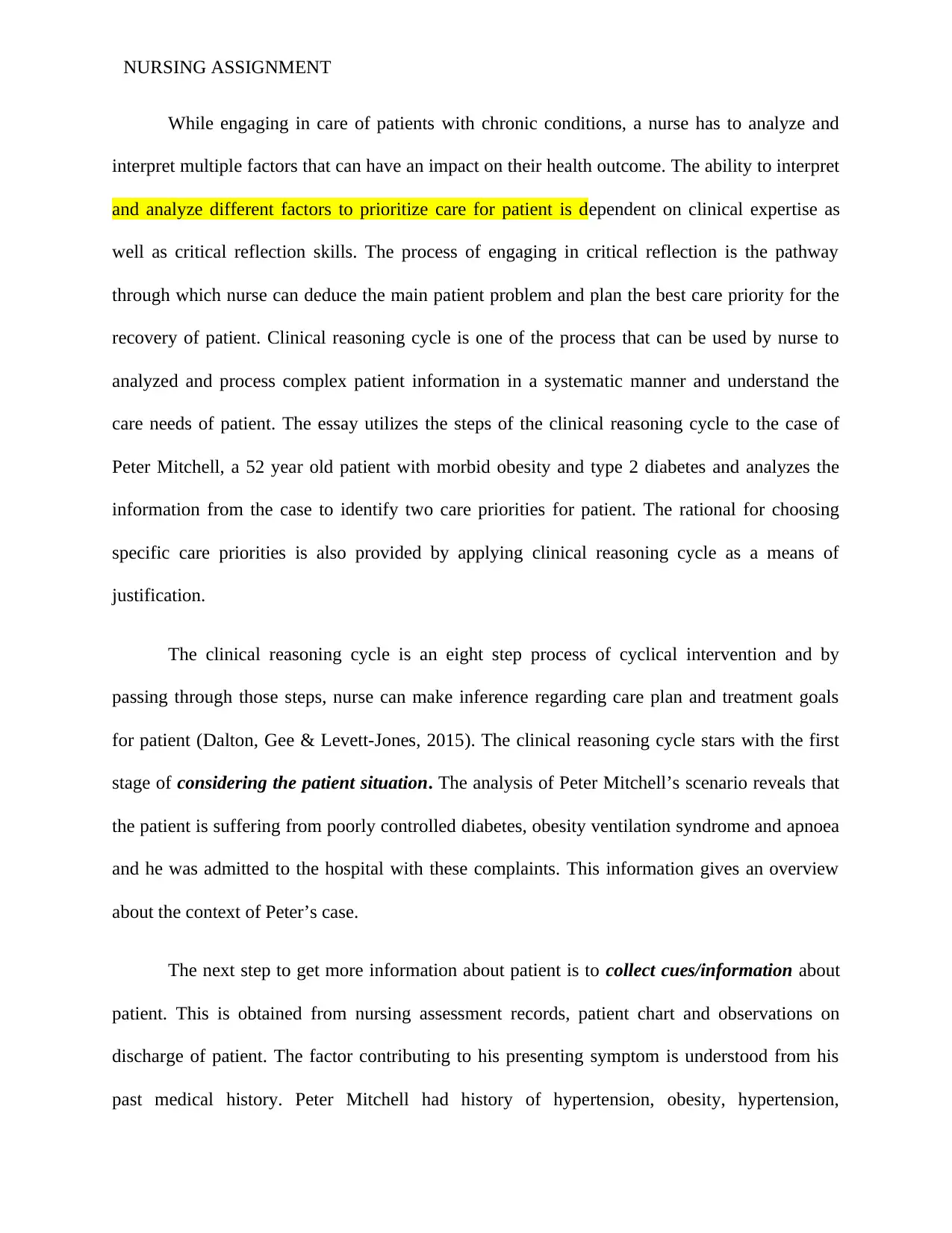
NURSING ASSIGNMENT
While engaging in care of patients with chronic conditions, a nurse has to analyze and
interpret multiple factors that can have an impact on their health outcome. The ability to interpret
and analyze different factors to prioritize care for patient is dependent on clinical expertise as
well as critical reflection skills. The process of engaging in critical reflection is the pathway
through which nurse can deduce the main patient problem and plan the best care priority for the
recovery of patient. Clinical reasoning cycle is one of the process that can be used by nurse to
analyzed and process complex patient information in a systematic manner and understand the
care needs of patient. The essay utilizes the steps of the clinical reasoning cycle to the case of
Peter Mitchell, a 52 year old patient with morbid obesity and type 2 diabetes and analyzes the
information from the case to identify two care priorities for patient. The rational for choosing
specific care priorities is also provided by applying clinical reasoning cycle as a means of
justification.
The clinical reasoning cycle is an eight step process of cyclical intervention and by
passing through those steps, nurse can make inference regarding care plan and treatment goals
for patient (Dalton, Gee & Levett-Jones, 2015). The clinical reasoning cycle stars with the first
stage of considering the patient situation. The analysis of Peter Mitchell’s scenario reveals that
the patient is suffering from poorly controlled diabetes, obesity ventilation syndrome and apnoea
and he was admitted to the hospital with these complaints. This information gives an overview
about the context of Peter’s case.
The next step to get more information about patient is to collect cues/information about
patient. This is obtained from nursing assessment records, patient chart and observations on
discharge of patient. The factor contributing to his presenting symptom is understood from his
past medical history. Peter Mitchell had history of hypertension, obesity, hypertension,
While engaging in care of patients with chronic conditions, a nurse has to analyze and
interpret multiple factors that can have an impact on their health outcome. The ability to interpret
and analyze different factors to prioritize care for patient is dependent on clinical expertise as
well as critical reflection skills. The process of engaging in critical reflection is the pathway
through which nurse can deduce the main patient problem and plan the best care priority for the
recovery of patient. Clinical reasoning cycle is one of the process that can be used by nurse to
analyzed and process complex patient information in a systematic manner and understand the
care needs of patient. The essay utilizes the steps of the clinical reasoning cycle to the case of
Peter Mitchell, a 52 year old patient with morbid obesity and type 2 diabetes and analyzes the
information from the case to identify two care priorities for patient. The rational for choosing
specific care priorities is also provided by applying clinical reasoning cycle as a means of
justification.
The clinical reasoning cycle is an eight step process of cyclical intervention and by
passing through those steps, nurse can make inference regarding care plan and treatment goals
for patient (Dalton, Gee & Levett-Jones, 2015). The clinical reasoning cycle stars with the first
stage of considering the patient situation. The analysis of Peter Mitchell’s scenario reveals that
the patient is suffering from poorly controlled diabetes, obesity ventilation syndrome and apnoea
and he was admitted to the hospital with these complaints. This information gives an overview
about the context of Peter’s case.
The next step to get more information about patient is to collect cues/information about
patient. This is obtained from nursing assessment records, patient chart and observations on
discharge of patient. The factor contributing to his presenting symptom is understood from his
past medical history. Peter Mitchell had history of hypertension, obesity, hypertension,
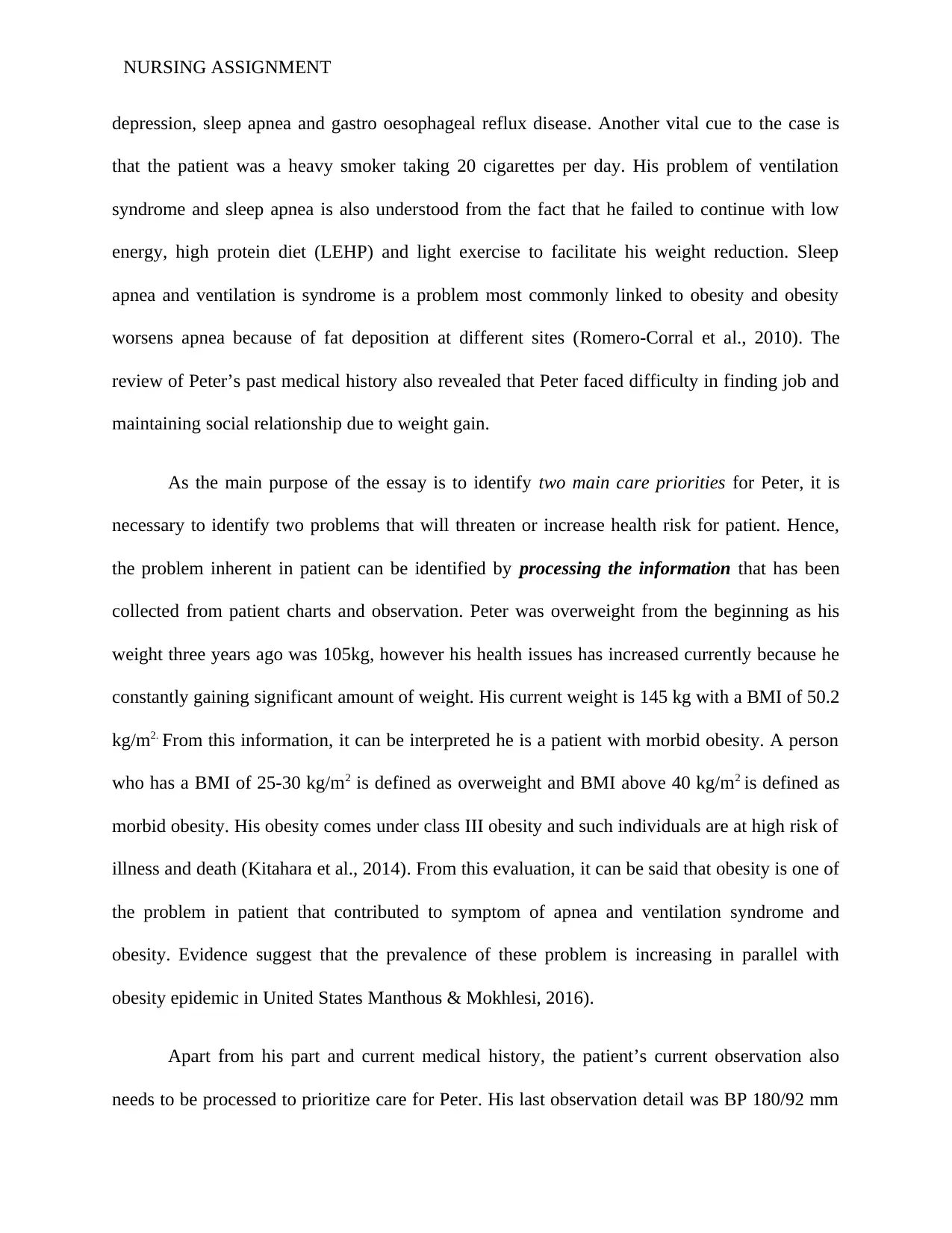
NURSING ASSIGNMENT
depression, sleep apnea and gastro oesophageal reflux disease. Another vital cue to the case is
that the patient was a heavy smoker taking 20 cigarettes per day. His problem of ventilation
syndrome and sleep apnea is also understood from the fact that he failed to continue with low
energy, high protein diet (LEHP) and light exercise to facilitate his weight reduction. Sleep
apnea and ventilation is syndrome is a problem most commonly linked to obesity and obesity
worsens apnea because of fat deposition at different sites (Romero-Corral et al., 2010). The
review of Peter’s past medical history also revealed that Peter faced difficulty in finding job and
maintaining social relationship due to weight gain.
As the main purpose of the essay is to identify two main care priorities for Peter, it is
necessary to identify two problems that will threaten or increase health risk for patient. Hence,
the problem inherent in patient can be identified by processing the information that has been
collected from patient charts and observation. Peter was overweight from the beginning as his
weight three years ago was 105kg, however his health issues has increased currently because he
constantly gaining significant amount of weight. His current weight is 145 kg with a BMI of 50.2
kg/m2. From this information, it can be interpreted he is a patient with morbid obesity. A person
who has a BMI of 25-30 kg/m2 is defined as overweight and BMI above 40 kg/m2 is defined as
morbid obesity. His obesity comes under class III obesity and such individuals are at high risk of
illness and death (Kitahara et al., 2014). From this evaluation, it can be said that obesity is one of
the problem in patient that contributed to symptom of apnea and ventilation syndrome and
obesity. Evidence suggest that the prevalence of these problem is increasing in parallel with
obesity epidemic in United States Manthous & Mokhlesi, 2016).
Apart from his part and current medical history, the patient’s current observation also
needs to be processed to prioritize care for Peter. His last observation detail was BP 180/92 mm
depression, sleep apnea and gastro oesophageal reflux disease. Another vital cue to the case is
that the patient was a heavy smoker taking 20 cigarettes per day. His problem of ventilation
syndrome and sleep apnea is also understood from the fact that he failed to continue with low
energy, high protein diet (LEHP) and light exercise to facilitate his weight reduction. Sleep
apnea and ventilation is syndrome is a problem most commonly linked to obesity and obesity
worsens apnea because of fat deposition at different sites (Romero-Corral et al., 2010). The
review of Peter’s past medical history also revealed that Peter faced difficulty in finding job and
maintaining social relationship due to weight gain.
As the main purpose of the essay is to identify two main care priorities for Peter, it is
necessary to identify two problems that will threaten or increase health risk for patient. Hence,
the problem inherent in patient can be identified by processing the information that has been
collected from patient charts and observation. Peter was overweight from the beginning as his
weight three years ago was 105kg, however his health issues has increased currently because he
constantly gaining significant amount of weight. His current weight is 145 kg with a BMI of 50.2
kg/m2. From this information, it can be interpreted he is a patient with morbid obesity. A person
who has a BMI of 25-30 kg/m2 is defined as overweight and BMI above 40 kg/m2 is defined as
morbid obesity. His obesity comes under class III obesity and such individuals are at high risk of
illness and death (Kitahara et al., 2014). From this evaluation, it can be said that obesity is one of
the problem in patient that contributed to symptom of apnea and ventilation syndrome and
obesity. Evidence suggest that the prevalence of these problem is increasing in parallel with
obesity epidemic in United States Manthous & Mokhlesi, 2016).
Apart from his part and current medical history, the patient’s current observation also
needs to be processed to prioritize care for Peter. His last observation detail was BP 180/92 mm
⊘ This is a preview!⊘
Do you want full access?
Subscribe today to unlock all pages.

Trusted by 1+ million students worldwide
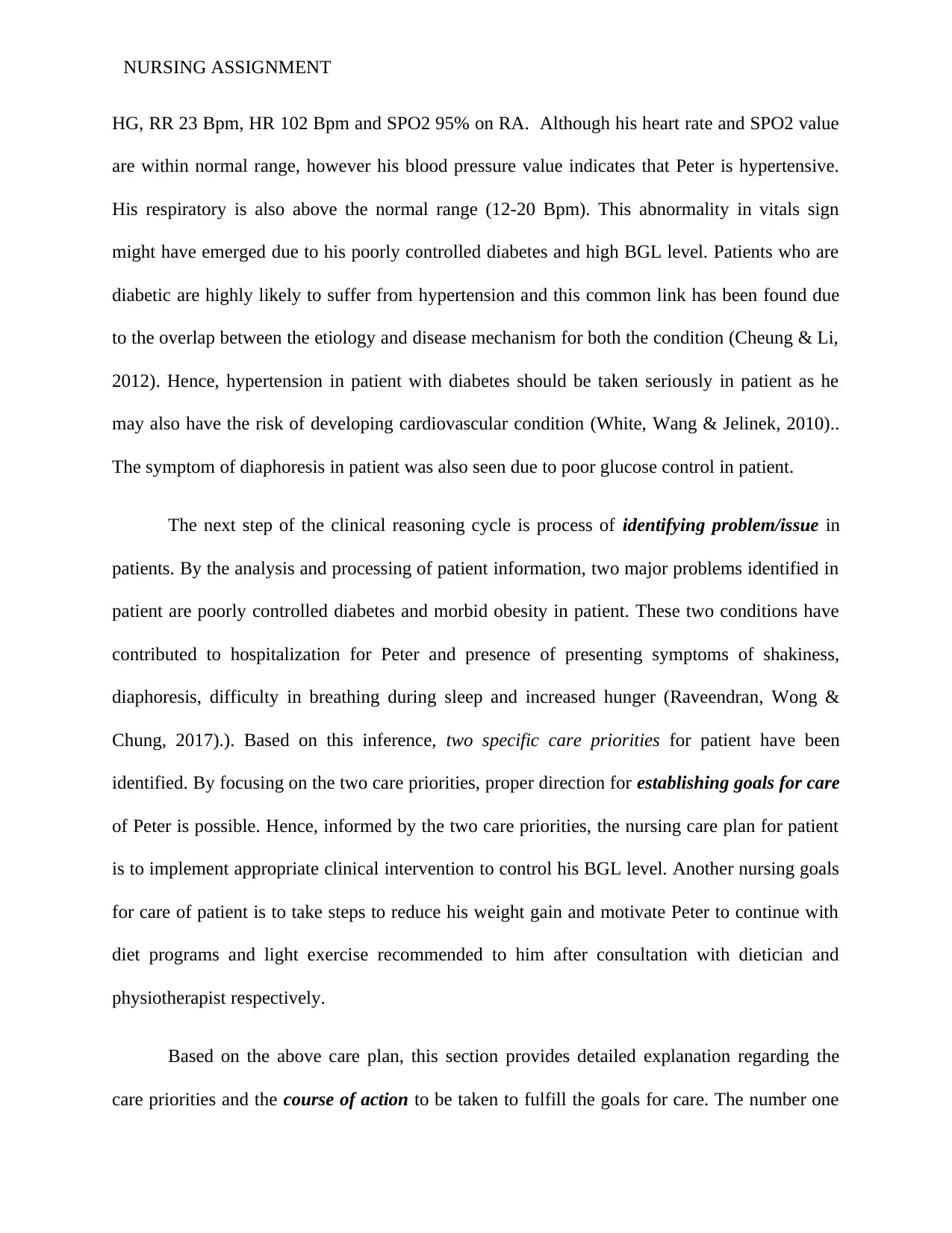
NURSING ASSIGNMENT
HG, RR 23 Bpm, HR 102 Bpm and SPO2 95% on RA. Although his heart rate and SPO2 value
are within normal range, however his blood pressure value indicates that Peter is hypertensive.
His respiratory is also above the normal range (12-20 Bpm). This abnormality in vitals sign
might have emerged due to his poorly controlled diabetes and high BGL level. Patients who are
diabetic are highly likely to suffer from hypertension and this common link has been found due
to the overlap between the etiology and disease mechanism for both the condition (Cheung & Li,
2012). Hence, hypertension in patient with diabetes should be taken seriously in patient as he
may also have the risk of developing cardiovascular condition (White, Wang & Jelinek, 2010)..
The symptom of diaphoresis in patient was also seen due to poor glucose control in patient.
The next step of the clinical reasoning cycle is process of identifying problem/issue in
patients. By the analysis and processing of patient information, two major problems identified in
patient are poorly controlled diabetes and morbid obesity in patient. These two conditions have
contributed to hospitalization for Peter and presence of presenting symptoms of shakiness,
diaphoresis, difficulty in breathing during sleep and increased hunger (Raveendran, Wong &
Chung, 2017).). Based on this inference, two specific care priorities for patient have been
identified. By focusing on the two care priorities, proper direction for establishing goals for care
of Peter is possible. Hence, informed by the two care priorities, the nursing care plan for patient
is to implement appropriate clinical intervention to control his BGL level. Another nursing goals
for care of patient is to take steps to reduce his weight gain and motivate Peter to continue with
diet programs and light exercise recommended to him after consultation with dietician and
physiotherapist respectively.
Based on the above care plan, this section provides detailed explanation regarding the
care priorities and the course of action to be taken to fulfill the goals for care. The number one
HG, RR 23 Bpm, HR 102 Bpm and SPO2 95% on RA. Although his heart rate and SPO2 value
are within normal range, however his blood pressure value indicates that Peter is hypertensive.
His respiratory is also above the normal range (12-20 Bpm). This abnormality in vitals sign
might have emerged due to his poorly controlled diabetes and high BGL level. Patients who are
diabetic are highly likely to suffer from hypertension and this common link has been found due
to the overlap between the etiology and disease mechanism for both the condition (Cheung & Li,
2012). Hence, hypertension in patient with diabetes should be taken seriously in patient as he
may also have the risk of developing cardiovascular condition (White, Wang & Jelinek, 2010)..
The symptom of diaphoresis in patient was also seen due to poor glucose control in patient.
The next step of the clinical reasoning cycle is process of identifying problem/issue in
patients. By the analysis and processing of patient information, two major problems identified in
patient are poorly controlled diabetes and morbid obesity in patient. These two conditions have
contributed to hospitalization for Peter and presence of presenting symptoms of shakiness,
diaphoresis, difficulty in breathing during sleep and increased hunger (Raveendran, Wong &
Chung, 2017).). Based on this inference, two specific care priorities for patient have been
identified. By focusing on the two care priorities, proper direction for establishing goals for care
of Peter is possible. Hence, informed by the two care priorities, the nursing care plan for patient
is to implement appropriate clinical intervention to control his BGL level. Another nursing goals
for care of patient is to take steps to reduce his weight gain and motivate Peter to continue with
diet programs and light exercise recommended to him after consultation with dietician and
physiotherapist respectively.
Based on the above care plan, this section provides detailed explanation regarding the
care priorities and the course of action to be taken to fulfill the goals for care. The number one
Paraphrase This Document
Need a fresh take? Get an instant paraphrase of this document with our AI Paraphraser
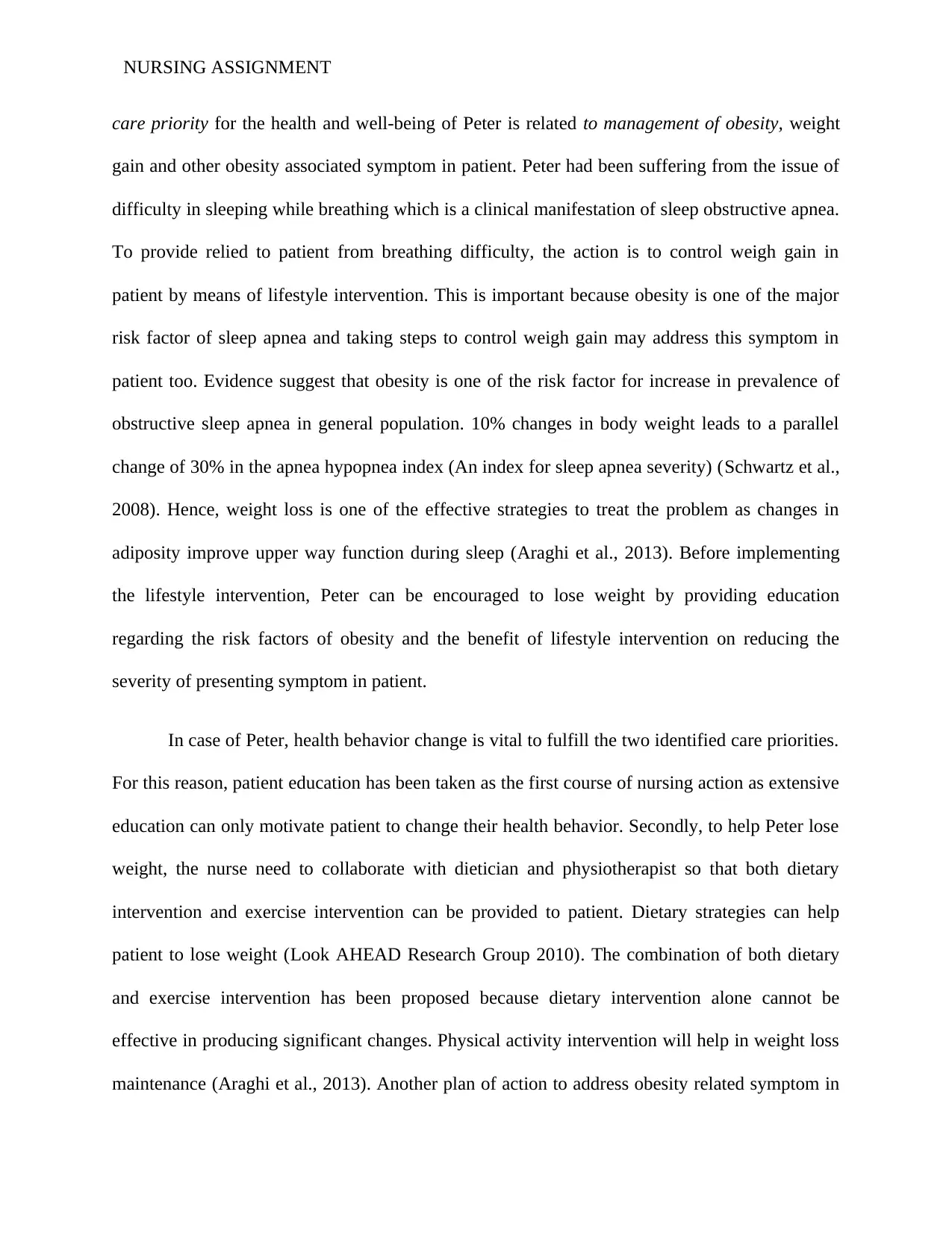
NURSING ASSIGNMENT
care priority for the health and well-being of Peter is related to management of obesity, weight
gain and other obesity associated symptom in patient. Peter had been suffering from the issue of
difficulty in sleeping while breathing which is a clinical manifestation of sleep obstructive apnea.
To provide relied to patient from breathing difficulty, the action is to control weigh gain in
patient by means of lifestyle intervention. This is important because obesity is one of the major
risk factor of sleep apnea and taking steps to control weigh gain may address this symptom in
patient too. Evidence suggest that obesity is one of the risk factor for increase in prevalence of
obstructive sleep apnea in general population. 10% changes in body weight leads to a parallel
change of 30% in the apnea hypopnea index (An index for sleep apnea severity) (Schwartz et al.,
2008). Hence, weight loss is one of the effective strategies to treat the problem as changes in
adiposity improve upper way function during sleep (Araghi et al., 2013). Before implementing
the lifestyle intervention, Peter can be encouraged to lose weight by providing education
regarding the risk factors of obesity and the benefit of lifestyle intervention on reducing the
severity of presenting symptom in patient.
In case of Peter, health behavior change is vital to fulfill the two identified care priorities.
For this reason, patient education has been taken as the first course of nursing action as extensive
education can only motivate patient to change their health behavior. Secondly, to help Peter lose
weight, the nurse need to collaborate with dietician and physiotherapist so that both dietary
intervention and exercise intervention can be provided to patient. Dietary strategies can help
patient to lose weight (Look AHEAD Research Group 2010). The combination of both dietary
and exercise intervention has been proposed because dietary intervention alone cannot be
effective in producing significant changes. Physical activity intervention will help in weight loss
maintenance (Araghi et al., 2013). Another plan of action to address obesity related symptom in
care priority for the health and well-being of Peter is related to management of obesity, weight
gain and other obesity associated symptom in patient. Peter had been suffering from the issue of
difficulty in sleeping while breathing which is a clinical manifestation of sleep obstructive apnea.
To provide relied to patient from breathing difficulty, the action is to control weigh gain in
patient by means of lifestyle intervention. This is important because obesity is one of the major
risk factor of sleep apnea and taking steps to control weigh gain may address this symptom in
patient too. Evidence suggest that obesity is one of the risk factor for increase in prevalence of
obstructive sleep apnea in general population. 10% changes in body weight leads to a parallel
change of 30% in the apnea hypopnea index (An index for sleep apnea severity) (Schwartz et al.,
2008). Hence, weight loss is one of the effective strategies to treat the problem as changes in
adiposity improve upper way function during sleep (Araghi et al., 2013). Before implementing
the lifestyle intervention, Peter can be encouraged to lose weight by providing education
regarding the risk factors of obesity and the benefit of lifestyle intervention on reducing the
severity of presenting symptom in patient.
In case of Peter, health behavior change is vital to fulfill the two identified care priorities.
For this reason, patient education has been taken as the first course of nursing action as extensive
education can only motivate patient to change their health behavior. Secondly, to help Peter lose
weight, the nurse need to collaborate with dietician and physiotherapist so that both dietary
intervention and exercise intervention can be provided to patient. Dietary strategies can help
patient to lose weight (Look AHEAD Research Group 2010). The combination of both dietary
and exercise intervention has been proposed because dietary intervention alone cannot be
effective in producing significant changes. Physical activity intervention will help in weight loss
maintenance (Araghi et al., 2013). Another plan of action to address obesity related symptom in
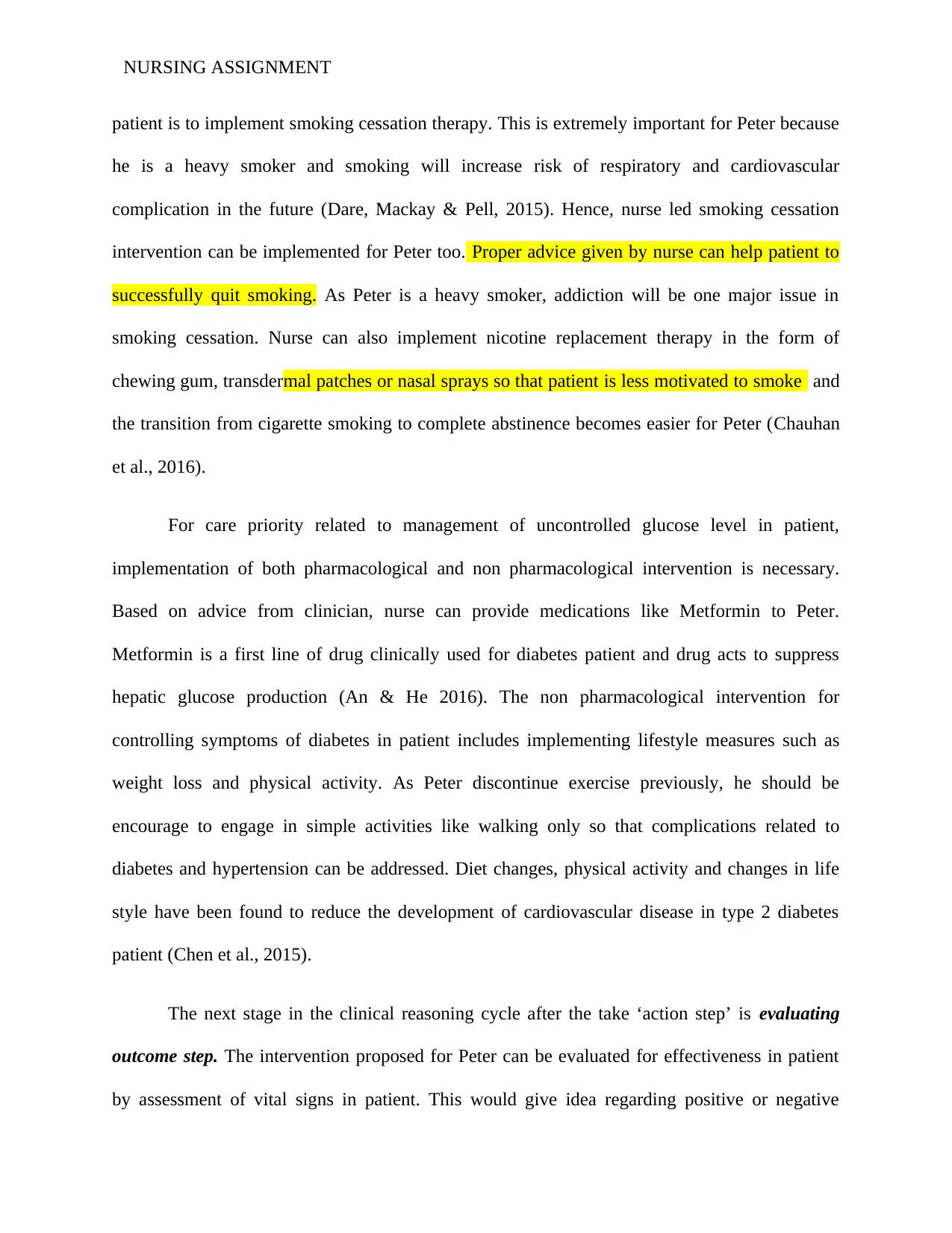
NURSING ASSIGNMENT
patient is to implement smoking cessation therapy. This is extremely important for Peter because
he is a heavy smoker and smoking will increase risk of respiratory and cardiovascular
complication in the future (Dare, Mackay & Pell, 2015). Hence, nurse led smoking cessation
intervention can be implemented for Peter too. Proper advice given by nurse can help patient to
successfully quit smoking. As Peter is a heavy smoker, addiction will be one major issue in
smoking cessation. Nurse can also implement nicotine replacement therapy in the form of
chewing gum, transdermal patches or nasal sprays so that patient is less motivated to smoke and
the transition from cigarette smoking to complete abstinence becomes easier for Peter (Chauhan
et al., 2016).
For care priority related to management of uncontrolled glucose level in patient,
implementation of both pharmacological and non pharmacological intervention is necessary.
Based on advice from clinician, nurse can provide medications like Metformin to Peter.
Metformin is a first line of drug clinically used for diabetes patient and drug acts to suppress
hepatic glucose production (An & He 2016). The non pharmacological intervention for
controlling symptoms of diabetes in patient includes implementing lifestyle measures such as
weight loss and physical activity. As Peter discontinue exercise previously, he should be
encourage to engage in simple activities like walking only so that complications related to
diabetes and hypertension can be addressed. Diet changes, physical activity and changes in life
style have been found to reduce the development of cardiovascular disease in type 2 diabetes
patient (Chen et al., 2015).
The next stage in the clinical reasoning cycle after the take ‘action step’ is evaluating
outcome step. The intervention proposed for Peter can be evaluated for effectiveness in patient
by assessment of vital signs in patient. This would give idea regarding positive or negative
patient is to implement smoking cessation therapy. This is extremely important for Peter because
he is a heavy smoker and smoking will increase risk of respiratory and cardiovascular
complication in the future (Dare, Mackay & Pell, 2015). Hence, nurse led smoking cessation
intervention can be implemented for Peter too. Proper advice given by nurse can help patient to
successfully quit smoking. As Peter is a heavy smoker, addiction will be one major issue in
smoking cessation. Nurse can also implement nicotine replacement therapy in the form of
chewing gum, transdermal patches or nasal sprays so that patient is less motivated to smoke and
the transition from cigarette smoking to complete abstinence becomes easier for Peter (Chauhan
et al., 2016).
For care priority related to management of uncontrolled glucose level in patient,
implementation of both pharmacological and non pharmacological intervention is necessary.
Based on advice from clinician, nurse can provide medications like Metformin to Peter.
Metformin is a first line of drug clinically used for diabetes patient and drug acts to suppress
hepatic glucose production (An & He 2016). The non pharmacological intervention for
controlling symptoms of diabetes in patient includes implementing lifestyle measures such as
weight loss and physical activity. As Peter discontinue exercise previously, he should be
encourage to engage in simple activities like walking only so that complications related to
diabetes and hypertension can be addressed. Diet changes, physical activity and changes in life
style have been found to reduce the development of cardiovascular disease in type 2 diabetes
patient (Chen et al., 2015).
The next stage in the clinical reasoning cycle after the take ‘action step’ is evaluating
outcome step. The intervention proposed for Peter can be evaluated for effectiveness in patient
by assessment of vital signs in patient. This would give idea regarding positive or negative
⊘ This is a preview!⊘
Do you want full access?
Subscribe today to unlock all pages.

Trusted by 1+ million students worldwide
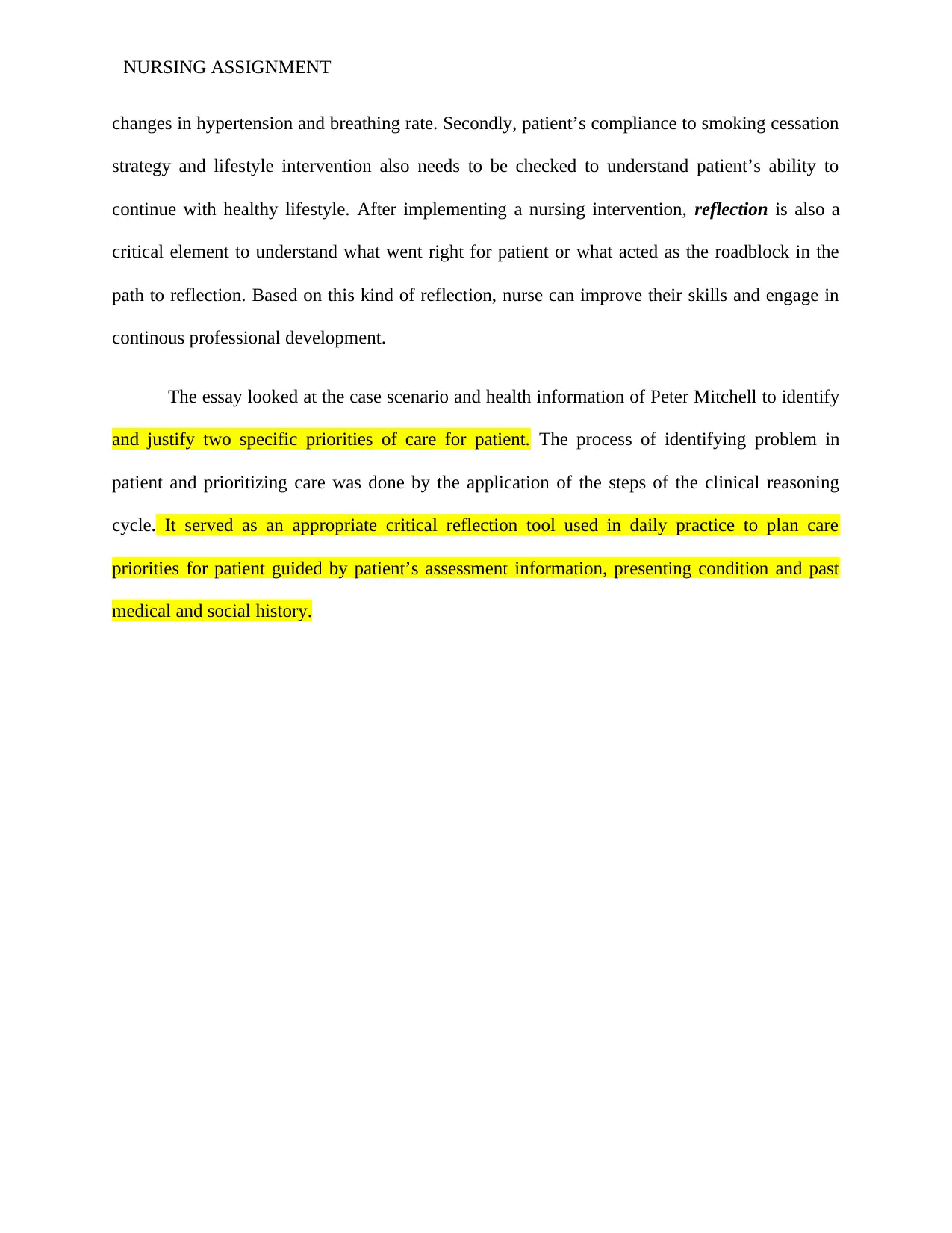
NURSING ASSIGNMENT
changes in hypertension and breathing rate. Secondly, patient’s compliance to smoking cessation
strategy and lifestyle intervention also needs to be checked to understand patient’s ability to
continue with healthy lifestyle. After implementing a nursing intervention, reflection is also a
critical element to understand what went right for patient or what acted as the roadblock in the
path to reflection. Based on this kind of reflection, nurse can improve their skills and engage in
continous professional development.
The essay looked at the case scenario and health information of Peter Mitchell to identify
and justify two specific priorities of care for patient. The process of identifying problem in
patient and prioritizing care was done by the application of the steps of the clinical reasoning
cycle. It served as an appropriate critical reflection tool used in daily practice to plan care
priorities for patient guided by patient’s assessment information, presenting condition and past
medical and social history.
changes in hypertension and breathing rate. Secondly, patient’s compliance to smoking cessation
strategy and lifestyle intervention also needs to be checked to understand patient’s ability to
continue with healthy lifestyle. After implementing a nursing intervention, reflection is also a
critical element to understand what went right for patient or what acted as the roadblock in the
path to reflection. Based on this kind of reflection, nurse can improve their skills and engage in
continous professional development.
The essay looked at the case scenario and health information of Peter Mitchell to identify
and justify two specific priorities of care for patient. The process of identifying problem in
patient and prioritizing care was done by the application of the steps of the clinical reasoning
cycle. It served as an appropriate critical reflection tool used in daily practice to plan care
priorities for patient guided by patient’s assessment information, presenting condition and past
medical and social history.
Paraphrase This Document
Need a fresh take? Get an instant paraphrase of this document with our AI Paraphraser
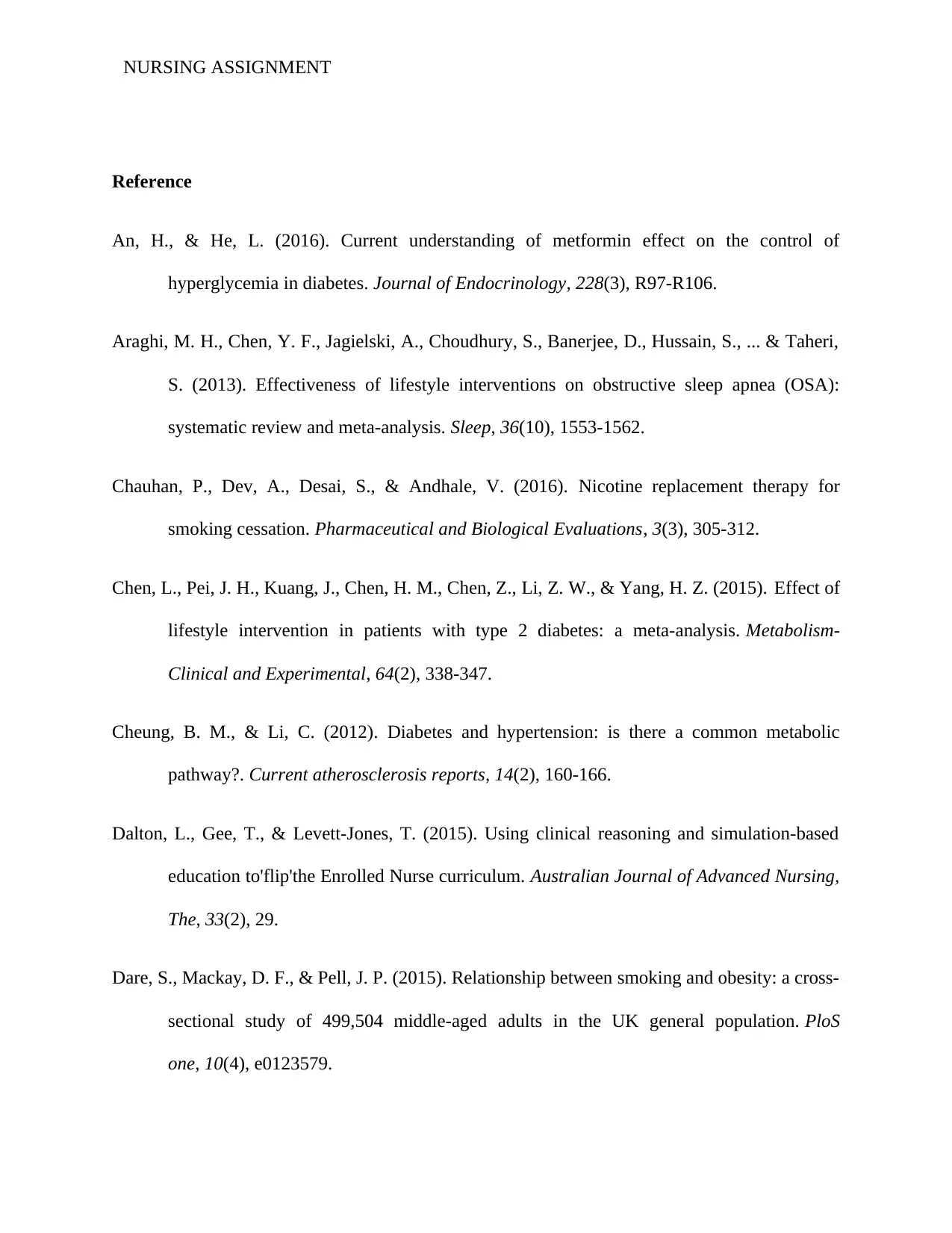
NURSING ASSIGNMENT
Reference
An, H., & He, L. (2016). Current understanding of metformin effect on the control of
hyperglycemia in diabetes. Journal of Endocrinology, 228(3), R97-R106.
Araghi, M. H., Chen, Y. F., Jagielski, A., Choudhury, S., Banerjee, D., Hussain, S., ... & Taheri,
S. (2013). Effectiveness of lifestyle interventions on obstructive sleep apnea (OSA):
systematic review and meta-analysis. Sleep, 36(10), 1553-1562.
Chauhan, P., Dev, A., Desai, S., & Andhale, V. (2016). Nicotine replacement therapy for
smoking cessation. Pharmaceutical and Biological Evaluations, 3(3), 305-312.
Chen, L., Pei, J. H., Kuang, J., Chen, H. M., Chen, Z., Li, Z. W., & Yang, H. Z. (2015). Effect of
lifestyle intervention in patients with type 2 diabetes: a meta-analysis. Metabolism-
Clinical and Experimental, 64(2), 338-347.
Cheung, B. M., & Li, C. (2012). Diabetes and hypertension: is there a common metabolic
pathway?. Current atherosclerosis reports, 14(2), 160-166.
Dalton, L., Gee, T., & Levett-Jones, T. (2015). Using clinical reasoning and simulation-based
education to'flip'the Enrolled Nurse curriculum. Australian Journal of Advanced Nursing,
The, 33(2), 29.
Dare, S., Mackay, D. F., & Pell, J. P. (2015). Relationship between smoking and obesity: a cross-
sectional study of 499,504 middle-aged adults in the UK general population. PloS
one, 10(4), e0123579.
Reference
An, H., & He, L. (2016). Current understanding of metformin effect on the control of
hyperglycemia in diabetes. Journal of Endocrinology, 228(3), R97-R106.
Araghi, M. H., Chen, Y. F., Jagielski, A., Choudhury, S., Banerjee, D., Hussain, S., ... & Taheri,
S. (2013). Effectiveness of lifestyle interventions on obstructive sleep apnea (OSA):
systematic review and meta-analysis. Sleep, 36(10), 1553-1562.
Chauhan, P., Dev, A., Desai, S., & Andhale, V. (2016). Nicotine replacement therapy for
smoking cessation. Pharmaceutical and Biological Evaluations, 3(3), 305-312.
Chen, L., Pei, J. H., Kuang, J., Chen, H. M., Chen, Z., Li, Z. W., & Yang, H. Z. (2015). Effect of
lifestyle intervention in patients with type 2 diabetes: a meta-analysis. Metabolism-
Clinical and Experimental, 64(2), 338-347.
Cheung, B. M., & Li, C. (2012). Diabetes and hypertension: is there a common metabolic
pathway?. Current atherosclerosis reports, 14(2), 160-166.
Dalton, L., Gee, T., & Levett-Jones, T. (2015). Using clinical reasoning and simulation-based
education to'flip'the Enrolled Nurse curriculum. Australian Journal of Advanced Nursing,
The, 33(2), 29.
Dare, S., Mackay, D. F., & Pell, J. P. (2015). Relationship between smoking and obesity: a cross-
sectional study of 499,504 middle-aged adults in the UK general population. PloS
one, 10(4), e0123579.
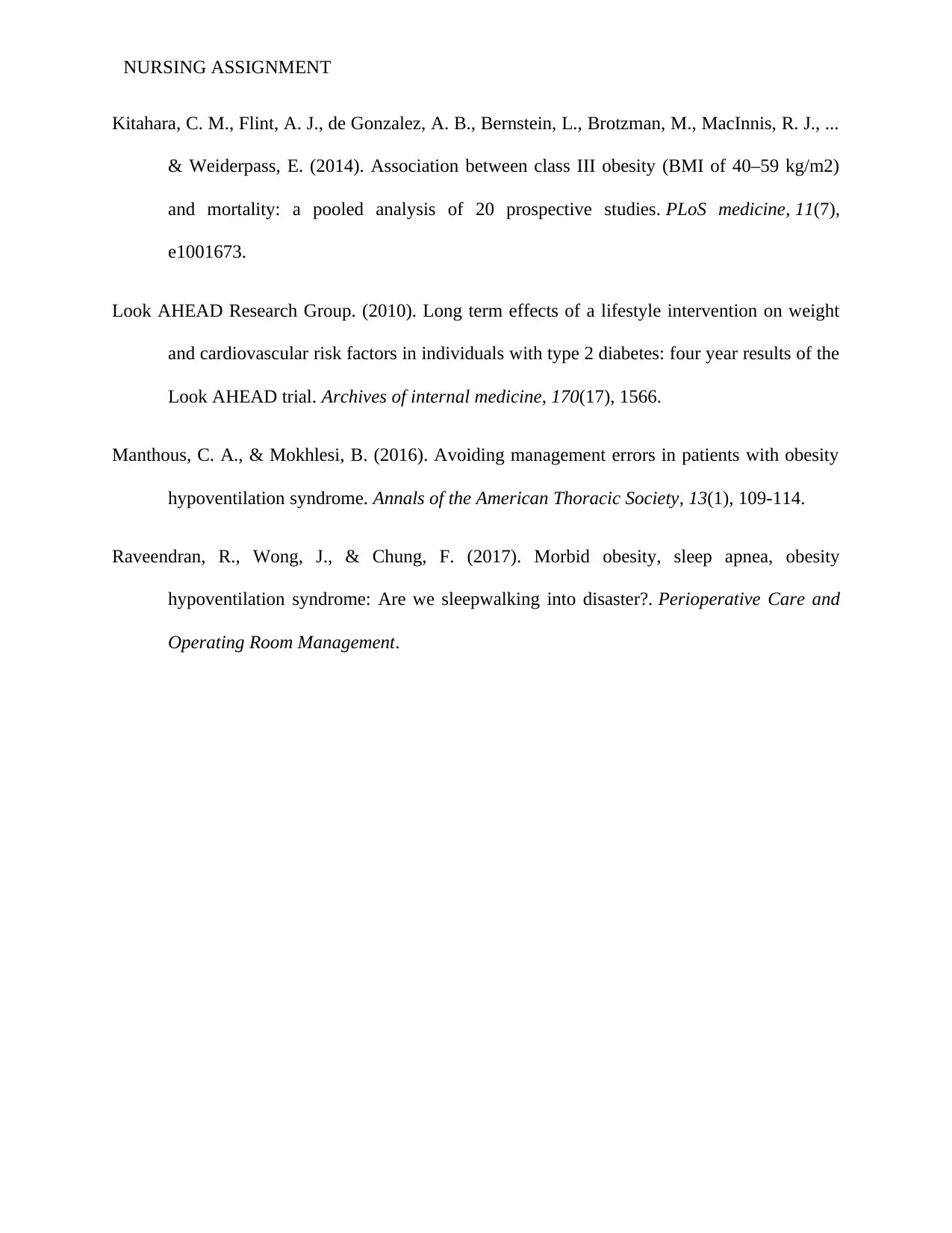
NURSING ASSIGNMENT
Kitahara, C. M., Flint, A. J., de Gonzalez, A. B., Bernstein, L., Brotzman, M., MacInnis, R. J., ...
& Weiderpass, E. (2014). Association between class III obesity (BMI of 40–59 kg/m2)
and mortality: a pooled analysis of 20 prospective studies. PLoS medicine, 11(7),
e1001673.
Look AHEAD Research Group. (2010). Long term effects of a lifestyle intervention on weight
and cardiovascular risk factors in individuals with type 2 diabetes: four year results of the
Look AHEAD trial. Archives of internal medicine, 170(17), 1566.
Manthous, C. A., & Mokhlesi, B. (2016). Avoiding management errors in patients with obesity
hypoventilation syndrome. Annals of the American Thoracic Society, 13(1), 109-114.
Raveendran, R., Wong, J., & Chung, F. (2017). Morbid obesity, sleep apnea, obesity
hypoventilation syndrome: Are we sleepwalking into disaster?. Perioperative Care and
Operating Room Management.
Kitahara, C. M., Flint, A. J., de Gonzalez, A. B., Bernstein, L., Brotzman, M., MacInnis, R. J., ...
& Weiderpass, E. (2014). Association between class III obesity (BMI of 40–59 kg/m2)
and mortality: a pooled analysis of 20 prospective studies. PLoS medicine, 11(7),
e1001673.
Look AHEAD Research Group. (2010). Long term effects of a lifestyle intervention on weight
and cardiovascular risk factors in individuals with type 2 diabetes: four year results of the
Look AHEAD trial. Archives of internal medicine, 170(17), 1566.
Manthous, C. A., & Mokhlesi, B. (2016). Avoiding management errors in patients with obesity
hypoventilation syndrome. Annals of the American Thoracic Society, 13(1), 109-114.
Raveendran, R., Wong, J., & Chung, F. (2017). Morbid obesity, sleep apnea, obesity
hypoventilation syndrome: Are we sleepwalking into disaster?. Perioperative Care and
Operating Room Management.
⊘ This is a preview!⊘
Do you want full access?
Subscribe today to unlock all pages.

Trusted by 1+ million students worldwide
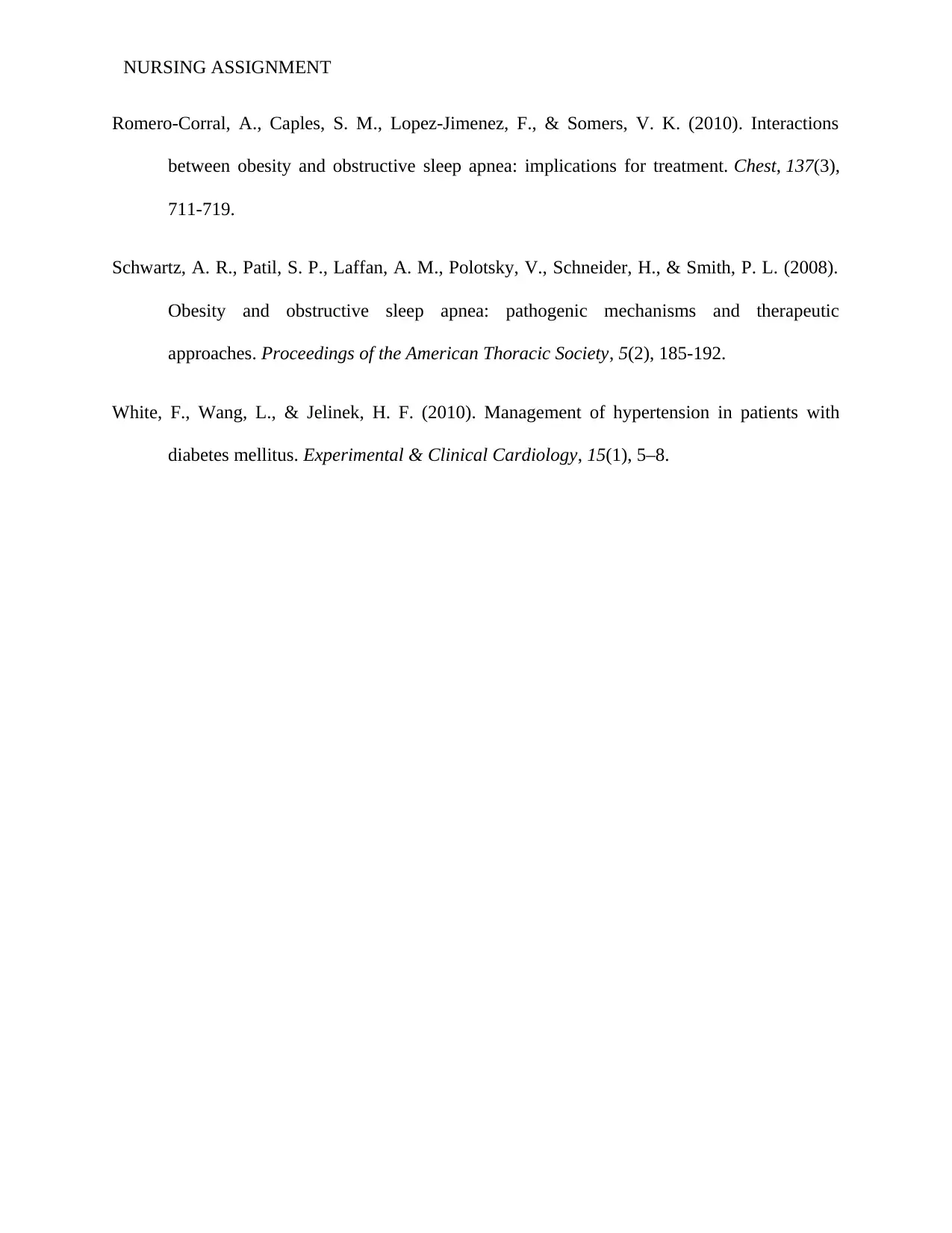
NURSING ASSIGNMENT
Romero-Corral, A., Caples, S. M., Lopez-Jimenez, F., & Somers, V. K. (2010). Interactions
between obesity and obstructive sleep apnea: implications for treatment. Chest, 137(3),
711-719.
Schwartz, A. R., Patil, S. P., Laffan, A. M., Polotsky, V., Schneider, H., & Smith, P. L. (2008).
Obesity and obstructive sleep apnea: pathogenic mechanisms and therapeutic
approaches. Proceedings of the American Thoracic Society, 5(2), 185-192.
White, F., Wang, L., & Jelinek, H. F. (2010). Management of hypertension in patients with
diabetes mellitus. Experimental & Clinical Cardiology, 15(1), 5–8.
Romero-Corral, A., Caples, S. M., Lopez-Jimenez, F., & Somers, V. K. (2010). Interactions
between obesity and obstructive sleep apnea: implications for treatment. Chest, 137(3),
711-719.
Schwartz, A. R., Patil, S. P., Laffan, A. M., Polotsky, V., Schneider, H., & Smith, P. L. (2008).
Obesity and obstructive sleep apnea: pathogenic mechanisms and therapeutic
approaches. Proceedings of the American Thoracic Society, 5(2), 185-192.
White, F., Wang, L., & Jelinek, H. F. (2010). Management of hypertension in patients with
diabetes mellitus. Experimental & Clinical Cardiology, 15(1), 5–8.
1 out of 10
Related Documents
Your All-in-One AI-Powered Toolkit for Academic Success.
+13062052269
info@desklib.com
Available 24*7 on WhatsApp / Email
![[object Object]](/_next/static/media/star-bottom.7253800d.svg)
Unlock your academic potential
Copyright © 2020–2025 A2Z Services. All Rights Reserved. Developed and managed by ZUCOL.





